How To Get More Speed Out Of My Boat
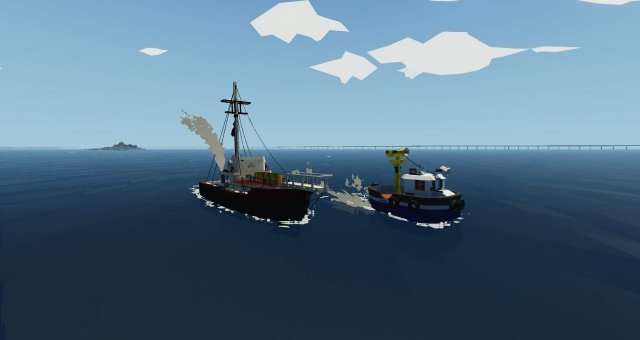
This guide aiming to give pointers how to design effective engines for most situations!
Contents
- Guide to Designing Engine
- Introduction
- Introduction to Engines
- Combustion Fundamentals (Unproblematic Factors)
- Designing a Gunkhole Engine (Combustion Just)
- Designing a Gunkhole Engine (Diesel-Electrical)
- Designing a Boat Engine (Electrical Assist)
- The Boat Designs Extra Credit
- Designing an Accommodating Helicopter for Medical & Rescue
- Designing an Accommodating Helicopter for Medical & Rescue pt 2…ish, Merely Not Really
- Actress Credit: Engoodening the All-Purpose Helo
- Extra Credit: Engoodening the All-Purpose Helo (Cont.)
- Actress Badly Designing a Combustion Engine for Boats
Guide to Designing Engine
Introduction
- This is a logical continuation of other guide nearly Gearboxes.
Information technology is not explicitly required reading if you already understand how gearboxes work, and/or don't feel like taking a deep dive into them. I will try and not to cover the same things covered at that place, including the engine basics department.
Then, engines. They're an unavoidable part of the vast majority of all builds in Stormworks. We're handling advanced mode, every bit dissimilar in basic mode you have to have about half of the vehicle'southward mass in engines to get it to go anywhere!
This guide will await you understand the absolute basics of the engine assembly, that is, how to hook up air, coolant, fuel, exhaust and ability, and sympathize the bones functions of the gearbox, clutch and generator components.
Introduction to Engines
We will non exist covering jet engines in this section because how they fundamentally piece of work very differently compared to the others. They may accept their own department in the future.
There are fundamentally three different kinds of engines, an oversight is given below:
Pure combustion engine

They come in 3 unlike sizes: Pocket-sized, large, and "oh god why". The main differences between the 3 different sizes are 3: How you hook them up, their "sugariness spot"(discussed afterward) and torque values.
Every engine tin can provide the same corporeality of RPS, although i take a distinct feeling this volition alter in the near future. Despite what may exist apparent from this guide's length, the way the engines work is really uncomplicated.
Pros:
- Electricity drain is minimal.
- Does not require a generator/alternator, and if desired can take only a fraction of engine functioning.
- The engine's functioning is like shooting fish in a barrel to predict in most cases.
- Fairly simple to set up.
- (Very) Lightweight in light setups.
Cons:
- Most fuel draw on all of the engine types.
- Most volatile to design mistakes.
- Grows heavy when y'all need a huge amount of ability due to literal tons of fuel.
- Prone to stalling.
Hybrid / Electric aid bulldoze
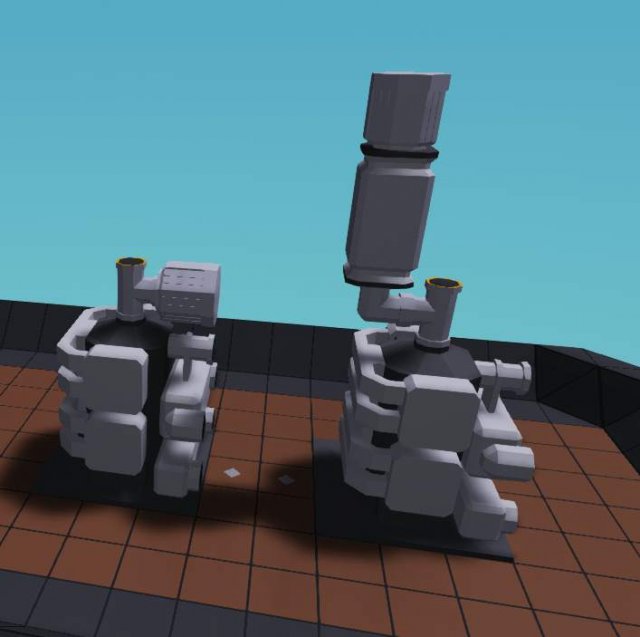
These are 2 drives that are fundamentally different, just they role so similarly i put them in the same category.
A hybrid drive toggles between electric drive being active with loftier battery, and disengages the electric drive at depression battery to let the battery to recharge and turns on the fuel engine. The aim is reduced fuel consumption.
An electric assist drive is active in tandem with the engine permanently to give information technology a boost in torque. It'due south ane method to fit a very powerful engine in a small packet. Information technology usually affects fuel economy negatively, but with a lot of tinkering can exist very close to having no effect on fuel economy.
Pros:
- Technically is allowed to stalling (Electrical Assistance / Electric fashion simply).
- Has loftier electric power generation.
- Can dial far beyond its size category in torque (Electric Assist).
- Very low fuel consumption (Hybrid drive).
- Relatively elementary setup (Electric assist).
- Scales meliorate to rising tonnage of vehicle.
Cons:
- Vulnerable to battery running out (as well as beingness struck by lightning).
- More complex design than conventional combustion engines (especially Hybrid).
- Excessively heavy in low-cal vehicles (Hybrid drive especially).
- Heavy weight of many batteries (tin exist neutral in cases where batteries can be utilized as anchor).
Pure electric drive with diesel generator
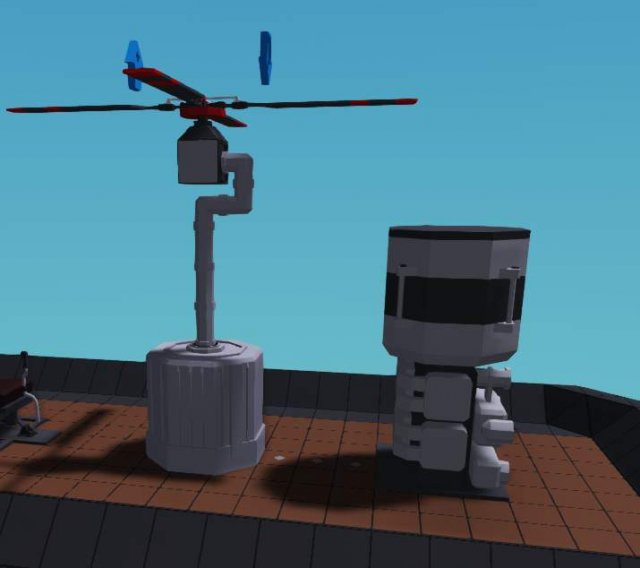
(Case only for illustration, doesn't actually piece of work as but equally this)
A setup common in very large freighters, besides as some newer electric cars as a fill-in generator. Information technology utilizes usually larger engines to produce electrical ability, which is then displaced and used elsewhere.
Pros:
- Very low fuel consumption when optimized.
- Easy to optimize engine(s) to provide generators every bit needed.
- Allows having engine and fuel where-ever you want while propulsion only needing a pocket-size amount of space.
- Absolutely incapable of stalling.
- Relatively simple setup.
Cons:
- Overwhelmingly heavy compared to other options.
- Needs even more batteries, making it even heavier.
Combustion Fundamentals (Unproblematic Factors)
I will keep this department equally information only, at that place'south a few key things on how diesel engines work in this game.
All these volition be using combustion engines, so refer back here if you lot're confused on some pattern decisions.
Heat
- The charge per unit that the engine heats upwards with is tied directly to its RPS value.
- We tin reduce estrus by pumping liquid (preferably h2o) through it.
- Nosotros tin can increase this oestrus reduction by pumping more liquid through it.
Output
- The torque output in the engine rises with the RPS.
- The RPS is variable, but tin can further be modified past a gearbox.
- The engine's maximum possible RPS drops based on the load forced onto the engine.
- Making the engine only partially engage via clutch reduces the load and allows college RPS.
Fuel
- The engine doesn't consume fuel based on load.
- The engine consumes fuel based on RPS; more RPS, college consumption.
Exhaust
Seemingly matters very little, and so long it can be freely output, it tin only exist properly measured by looking at the engine for whether or not there is plenty exhaust output. Visually, you will go thicker plumes of smoke unless you direct it through more frazzle pipes.
Air
Requires more air for more RPS on the engine, but has no existent consequence sucking up incredible amounts of air without any kind of compressor
Using this checklist and but this checklist, we can design all types and kinds of engines.
Designing a Boat Engine (Combustion Only)
Dude, what if nosotros exploded a dinosaur to brand a gunkhole go forward?!
We're going to be using this old, gutted speedboat design of mine. It's an old dog, fabricated around version 0.4, which would be around the rocking 80'south in game evolution terms, that'southward why information technology has such a silly name and colour scheme!
This is a build-along, so load up Stormworks and let's start going!
The dreaded theory department (that'due south actually curt)
"The general who loses a battle makes simply a few calculations beforehand. " Sunday Tzu, The Art of War
Yes, i'grand dropping Dominicus Tzu's wisdom on y'all (and padding this to brand it look longer than information technology is).
Nosotros will be dealing with a load (what the engine is working). The propeller is at its heaviest when in the h2o, and can only give propulsion in information technology, the elevate of the body is the but notable thing that'due south preventing the propeller from turning. We tin determine from this that we're dealing with a abiding load (outside of planing!).
- This, effectively ways that nosotros are perfectly fine with having one gear.
- We have literally infinite coolant. We don't need coolant tanks, we can utilise seawater directly
The 2nd theory section
The whatnow?
Well, nosotros're making a boat with a specific design, so let's consider the office of how a boat works on water, and more than specifically, how this boat works on h2o.

This is what the boat looks from the side, we tin can encounter the pair of props to the right, the center of mass in pink (i've added engines already), and that'south all we demand to know. Let me apply some MS pigment to the epitome.

The heart of mass works like the fulcrum (the center point of a lever) in a see-saw. Our eye of thrust (blue arrow) is below the center of mass, which causes the nose to elevator up(light purple arrow). This is something that'southward desirable in a speedboat, but information technology is non desirable otherwise. The bow will as well want to lift itself off of the water because the water has more than resistance to motion (drag) than air, which also causes lift.
In large commercial vehicles the props are often angled so they don't provide upward bow lift similar this. In boats, we by and large want nigh of the weight toward the front to reduce this lift, which makes it far more controllable and easier to handle.
I'k all theoried out, what at present?
The theory is simply for learning how to recollect about these little blueprint challenges, some people can fly information technology, others need to call back almost it. Generally being able to wing a pattern comes with exercise.
The boat comes with premade hull and cockpit, fuel tank, and exhaust arrangement. Everything else, we're going to brand.
At present, nosotros build some stuff
Edifice some stuff
We're going to demand 2 engines. Place them toward the forepart. How you place them is your ain call, and where y'all place them is your own call. This is how i placed mine. If you place your engines this way, make sure to mirror (U) one of the engines and so the pipes are on the same side.
Allow's claw up the cooling now, since we're operating a gunkhole, nosotros take an ocean-sized cooling tank.
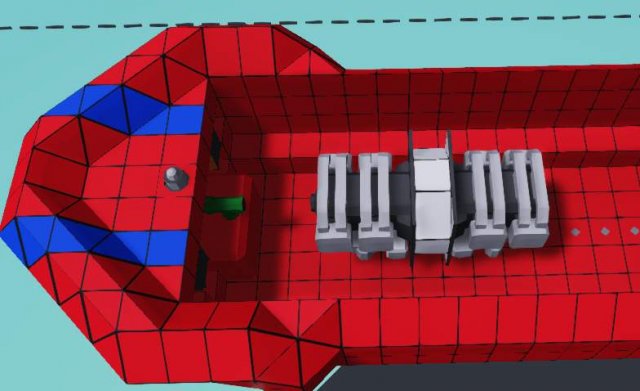
I made a small extension to the bottom of the gunkhole for sucking up water. It's constructive plenty with its current alignment and doesn't really need anything actress, it'll happily suck up all the seawater running against it. Y'all tin can also lay the inputs flush confronting the bottom, but a bulge like this adds more drag which makes it harder for that part of the boat to lift off the water, and gives more expanse for it to suck up cooling seawater. You could have a pump here, but it's not exactly necessary.
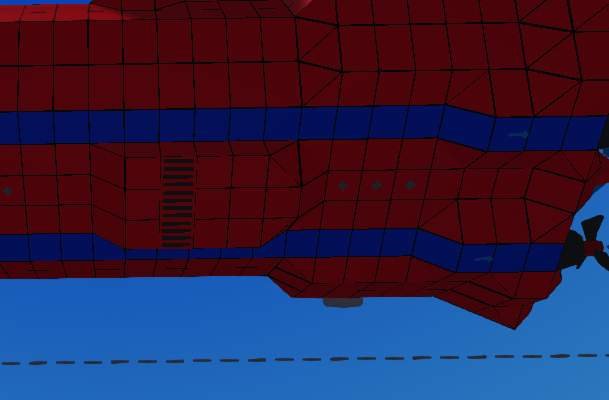
For getting rid of the hot coolant, i only put a couple of fluid ports directly below the ladder on the back and piped my way over there, my internals now look like this. Color coding pipes is adept for sorting them out later, you should exercise it!
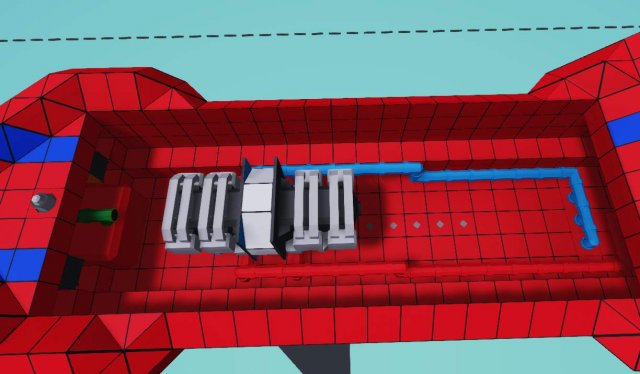
This is what a fully hooked upwards (except for ability) engine looks similar. I opted to accept equal hookup for the engines instead of one per prop, at that place are upsides (losing one engine all the same allows you to go straight only fine) and downsides (tin't engine steer, slightly lower performance with turns) with this kind of design, but information technology'southward easier from a piping management perspective, even though there'due south plenty of space.
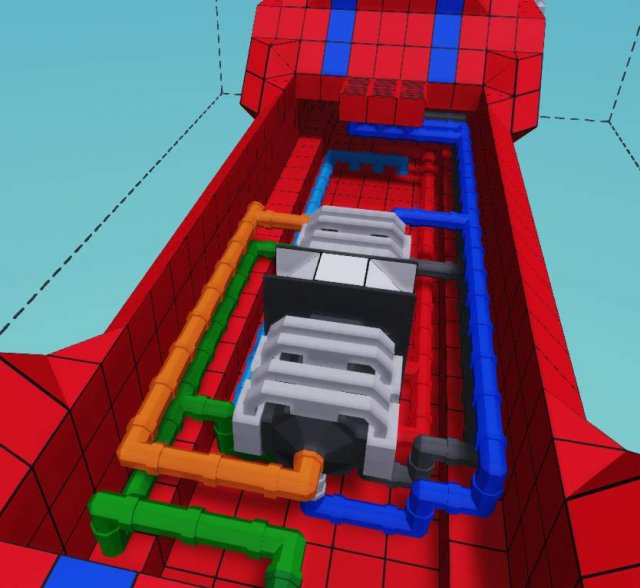
Now since this is an engine blueprint guide, and not gunkhole beauty pattern guide (patent pending) i won't walk you through hooking up fuel, air and frazzle, just make sure the air intake gets air. How they're hooked up and designed are upwards to you, you can even increase the corporeality of fuel if it does (but for now i recommend you leave those other tanks empty, equally they shift the weight a lot).
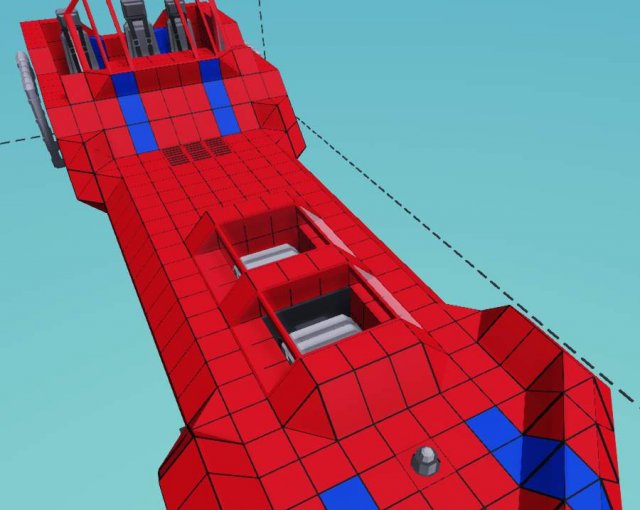
Now hook up the engines straight to the props (this is for testing purposes), then practise all the necessary electronics and finally build a cover for the craft without leaving whatever gaps then this thing can really float. Y'all'll find the ignition button pre-installed, just hook up throttle to due west/s or install a throttle lever as you wish. The speedo on this thing is broken (because it'south old), y'all tin can install a proper speedometer or just go past how it feels. We'll be doing the tuning after nosotros have a exam run!
You should at least hook upward these:
- RPS.
- Estrus.
- Fuel.
Test results
So, we probably agree on these test results:
- The affair is fast as hell, and about as mad.
- Trying to turn at total speed causes disasters to happen.
- The thing hits total RPS, and chews through fuel.
- It eventually blows upward due to insane engine stress.
- The gunkhole planes as well difficult.
Dealing with the examination results
Let's address the positives:
- It's fast for a normal prop driven speedboat, this is desirable.
- It looks rad.
That'southward the positives, all of them. We probably desire to attack how the engines work, limiting their RPS is one way, but since loading them down doesn't cause more than fuel usage, the meliorate way, in my opinion, is to put in a gearbox with high gearing that forces the engines to run at lower RPS. We'd want to do this anyhow to get a opposite gear.
Install one gearbox, and gear it at one:3 (note which fashion you're installing it), then accept it for another test-run. The goal is to repeat the test run with unlike gearings until your engines sit around at 8 RPS, which is the desirable sweetspot for small engines. Since our engines are both tied to the same driveshaft, we can get away by merely watching one'south stats.

Deliberating
With the one:iii gearbox you should notice that we reach about half the RPS that we desire, then naturally yous'd think nosotros need half the gearing, right? It'due south not quite equally simple every bit that, as these things piece of work on a curve. Try tuning it down to 1:ii (33% less) to see what the upshot is.
With 1:2 gear, y'all tin can reach > x RPS, which ways that nosotros're really putting out more power in those props than with 1:1 gearing. I could achieve 30m/s speed, merely it was extremely uncontrollable. Since there is a gear between these 2 not as desirable outcomes of opposing ends, we can pick that one and take the 5:2 for a ride.
Conclusions
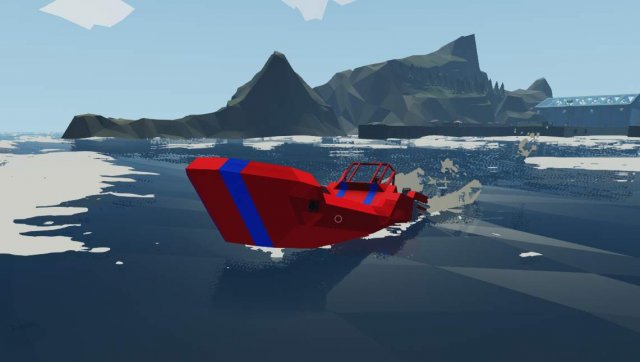
With these designs we have determined a good compromise for a gear and fabricated a pretty decent engine for a relatively decent speedboat. It uses relatively small amount of fuel for rather solid performance, and it'south sort of stable while doing it.
But… we could practise better, couldn't nosotros? Nosotros'll see this craft again.
Designing a Gunkhole Engine (Diesel fuel-Electric)
We're using this sweet dinghy as a footing
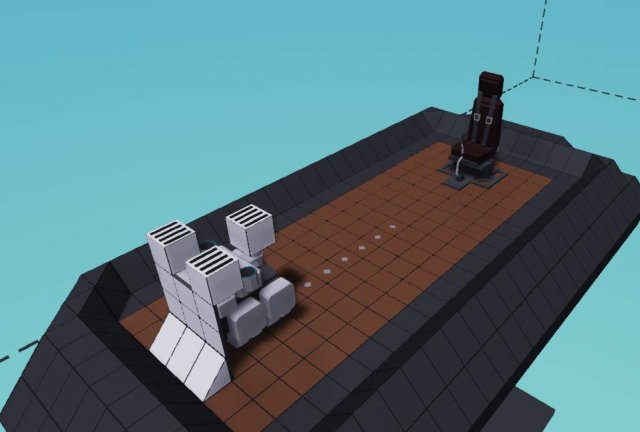
We'll commencement off correct off the bat with a bang. Build an engine every bit shown and adhere fluid ports directly to cooling and air.
Follow it up with an exhaust pipe that doesn't blow the exhaust in your optics and a fuel tank.

And finally, a pair of gearboxes every bit shown with a generator stuck on them as shown.

The electric stuff!
Yes, we're actually done with the engine (or rather, generator) we will tune those gearboxes after.
Open up upwards the back of the boat (i've colored the insides white for seeing the insides more easily) and install a prop every bit shown.
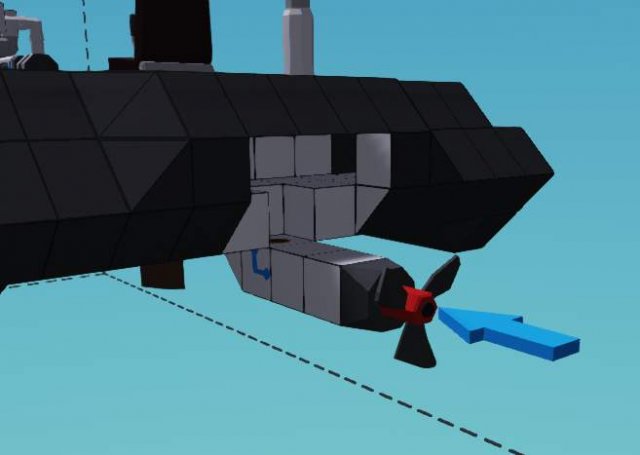
Pipe up from the prop and adhere a pair of electric motors as shown.
This is all the space we need for our propulsion. Compared to that monstrosity from before, it'southward really compact, isn't it (apart from the large engine in the front, of grade…)? Recollect, gearboxes take no positive outcome on electrical motors!
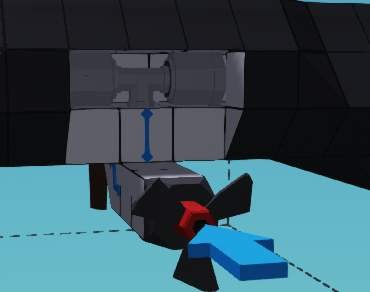
Brand very sure to close off the pigsty subsequently you're done completely. The dinghy depends on its flotation ring to stay on the surface. It is non sectioned off at any point, so leaving whatsoever points open will turn it into a submarine.
Now wire up the electrics!
Testing time!
Wire upward a constant number of ane to the throttle of the engine, and a starting button.
Nosotros're concerned nigh 2 things here: Energy production, and energy drain. Nosotros should really simply concentrate on energy product commencement.
Hither's the dials (or other readouts) that we desire:
- Generator output (Yes, really, one and merely).
What nosotros're looking for
- Highest possible generator output, what else?
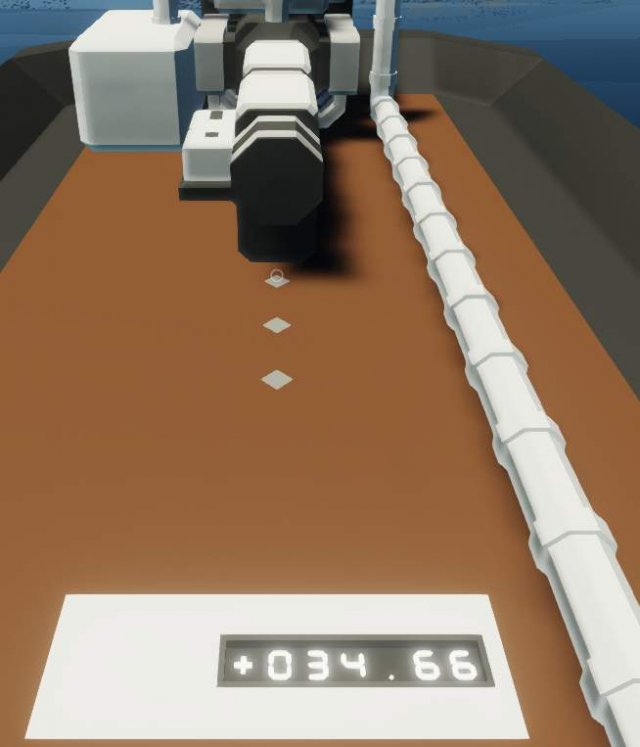
I happen to know to become to this effigy y'all need somewhere between 1:7 to 1:9 ratio. You lot can do some maths, tin't yous? For those too lazy to count, ane:3 and 2:v (or i:2.5) after each other is ane:2.5*iii, or one:7.5, which is proficient enough.
On the left you lot tin encounter what we're looking for every bit a good generator output.
Testing time, round 2!
Round 2? Well, since we're working 2 systems, we demand to test 2 things!
Here's the dials (or other readouts) that we want:
- Battery (the dinghy comes with a battery multiplier that ways we tin can become % readout on the bombardment, really useful).
- Fuel capacity (so we can decide how little fuel we're using).
At present, before we determine what we're looking for… wire up ane of the electrical motors straight to the seat, and take it for a ride until your batteries run out to around eighty%, and then turn on the generator, and go along riding.
What this mini exam showed is 3 things:
- Batteries on their own run out really fast.
- The generator puts out more than we need (this is why nosotros have 2 motors).
- The thing uses a neglible amount of fuel.
What we're looking for
In a arrangement like this you want equally close as possible for most 100% (or more, if you're OK with short pauses here and there in merchandise of more than power output) utilization of the engine's power generation.
Wire up both of the motors now and accept information technology for a ride.
What this test showed is ii things:
- Information technology's style faster without affecting how much fuel is consumed.
- The bombardment is draining..
This means basically that nosotros need to split our throttle to the motors. Without a somewhat complicated automated system that balances the throttle based on delta (difference) in the batteries being negative… y'all can get to this figure by but throwing a couple of educated guesses.
I left my divider microcontroller in the dinghy'south flotation part, and the effigy should be tuned to slightly drain the battery while driving around, just also giving information technology impressive range.
So what have nosotros learned (peradventure):
- The engine at the front makes sure the dinghy doesn't plane.
- Not planing reduces the potential speed, simply likewise makes the ride much more stable.
- Making a generator organization is very piece of cake.
- Generators use very little fuel, and it allows practically hiding the propulsion system.
- Batteries without generators run out very quickly.
Designing a Boat Engine (Electric Assist)
So, allow's discuss a niggling fleck on the weirdness of this system.
Electric assist is a piffling bit difficult to sympathise as information technology immediately doesn't seem to accept many benefits, and it's made fifty-fifty more confounding as there'due south multiple ways to set information technology upward. Essentially what'll happen is that you're taking some of the engine'southward power output to generate electricity, which y'all'll then use to force the engine to run at a college RPS.
It sounds like it shouldn't piece of work, and it sounds similar information technology should be overunity, but engines have a sweetness spot for power output, to sum information technology up just, the more than you rev upwards an engine, the more torque information technology puts out on a curve. The "sweet spot" i keep referring to is different for every engine, for small engines it is effectually 8, where it doesn't use also much fuel to put out the ability in question. We're using the electric motor to forcefulness the engine to plow, like to a starter motor.
The secondary benefit is that you as well get quite a flake of electricity for your other systems every bit a necessity for this thing's role.
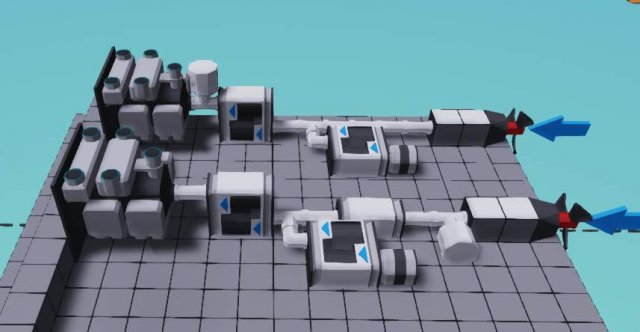
In that location's 2 chief setups for this kind of engine:
One that's directly hooked up to the engine (in a higher place), this is where the electric motor'due south throttle is ofttimes limited to curb the hit on the batteries, which reduces how much yous need to give to the generator.
One that's hooked up to the output, where the engine gives one-half or more of its ability (regulated past the clutch between the engine and electric motor), and near of the electric motor is directly tied to the output.
This kind of design is useful in systems where you often demand to reverse, so yous can just disable the clutch betwixt the engine and the power output, which gives 100% of the engine power to the generator and 100% of the motor to the output, which allows gearbox-less contrary. This can also work as a hybrid organization.
We still have some things to think most, but at to the lowest degree it'due south only 2 components and their quirks.
Generators: They depend on RPS, giving out more ability per rotation put in, only equally a downside they likewise crave more than torque per rotation as the rotations increase. This wasn't a thing before, which made information technology easy to brand overunity generators. We need to remainder this then we don't rob too much of engine power merely to brand electricity.
Motors: They give out significantly more power at college bombardment charge… considering the electrical system in this game is a little chip airheaded. They give a 100% at 100% battery, and drop out to at an estimate 40% of output at 50% battery, after which they no longer drib down, so we need to continue the battery above 90% at all times, preferrably 95%. This simply ways nosotros demand more batteries and bigger batteries.
Let'due south stop waffling and start building
We'll be using the same speedboat design as in the very showtime engine design, so get fetch the workshop link from there if you lot haven't already. Our goal is to attempt to get shut to similar functioning (!) while only using one pocket-sized engine.
To attempt not to echo myself likewise much, i won't be walking you through hooking upwards the engine once again, it'south done in exact the same way every bit in the combustion section, so claw it up fully without gearboxes or anything special, seal up the top of the speedboat, and take it for a examination ride. Besides, at that place's enough text in this guide. Every bit before, the design decisions for the intakes and whatnot are completely up to yous.
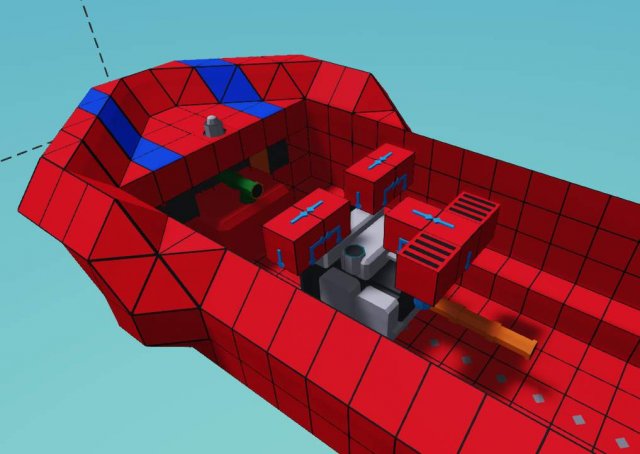
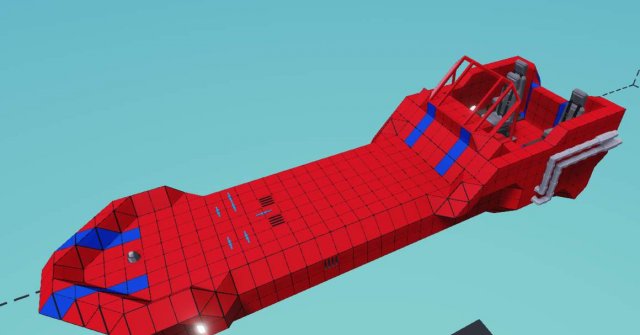
The test results
Let's take a fleck of a moment on thinking about the factors hither:
- The speed is good, merely it is too a little hard to control.
- The RPS of the engine hits the cap.
- The engine heats upwards quickly.
- The engine uses up a lot of the fuel.
Let's attack those problems first past introducing a gearbox. To salvage on fourth dimension and effort, a good compromise for a gearbox here is ii:3 ratio, it gets your engine to 9 RPS with a speed of slightly below 10m/s (knowing these values is important for tuning). It for at present deals with all the issues and kills the speed, just this is only temporary.
Let'south electrify that boat! Electricity is super constructive against h2o!
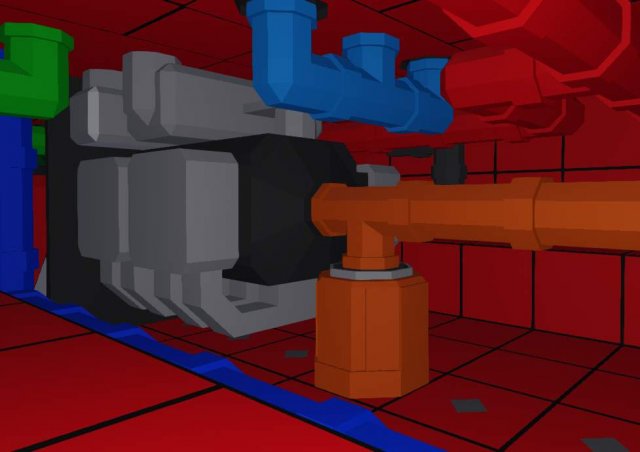
We'll be designing the first system shown on the topmost paradigm of this guide, and then brand a T-department pipe next to your engine'due south ability output and slap an electrical motor onto information technology.
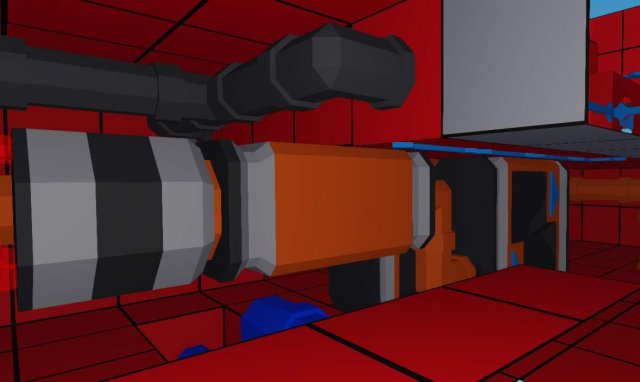
It's a little cramped in here.
Next, nosotros make the gearbox and clutch system leading to the generator behind the currently existing gearbox (since we want equally many RPS as possible).
At present let's wire things upwardly
Put a 1:3 ratio on the generator and hook up the clutch to a throttle lever while hooking up the electricity. The throttle lever is a temporary measure then we tin can figure out a good clutch ratio for this without making an automated system (which is better, but harder to guide through!).
You also want to halve the throttle of the motor so we're non using as well much energy, so either split up the throttle input past 2 or multiply it by 0.5, your call. This is the same throttle you're controlling the engine with, so if you're using due west/s, wire information technology to that.
Test results, circular two!
So… the bombardment is draining, even with 100% generator clutch, why is that?
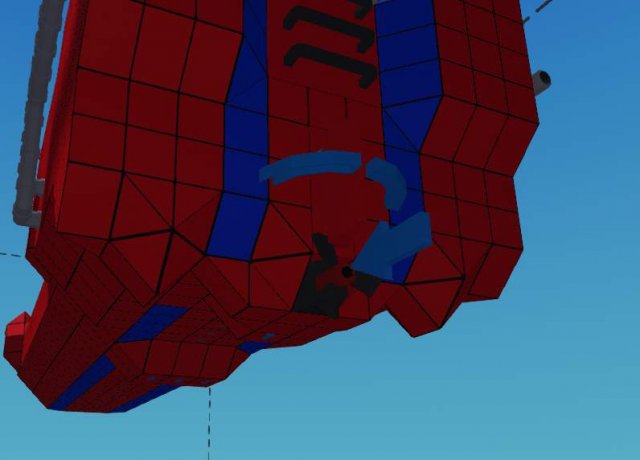
Well, we're actually pushing the engines too hard in this case, and then we're going to have to change the body a little. Remove the twin props at the back and install a single cardinal one in their place. Now take it for a test run without changing anything else.
Examination results, third fourth dimension'south the charm!
Nosotros've boosted the engine pretty notably. We achieve 12-13 RPS at present, and we can reach college speeds, yet despite this, we don't seem to be using more than fuel than before. The battery drain is still pretty high, and nosotros have to let the engine rev up before nosotros throttle up the generator clutch and so that the matter starts generating.
So how do we come up up with a solution where we don't have to screw around with the clutch manually all the time? Let'south try something simple. We know our summit RPS is about 12, then nosotros desire a figure that'due south around 0.75 clutch (a skillful compromise that can be establish out by testing unlike values and driving around a while, all while looking at the bombardment value).
It turns out 12 divided by 16 is 0.75, then we can hook up the RPS of the engine to control the generator clutch, and so long we divide the RPS by xv. "But wait, you said…" yeah, that's the peak of the engine performance. Waves are tossing the boat effectually and the RPS bounces around and then we have to take a little flake of leeway with it, this is just to ensure we have the bombardment being charged.
Results!
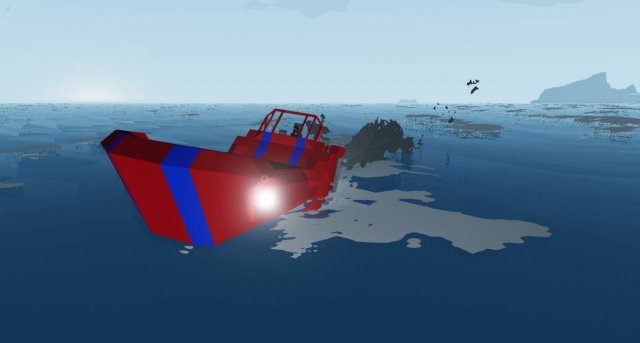
We accept managed to get equal performance with the twin combustion engine, despite the setup being more complicated, nosotros're actually using less fuel and we have energy generation in place, probably plenty to even run a floodlight or ii permanently.
Even if the engine RPS is probably college than we want, and nosotros could have fifty-fifty lower fuel consumption, our goal was to hitting the performance of the previously designed twin-engine powerboat
This organization can also be applied on the twin engine setup to make it even more than powerful.
No affiliation with that absolutely awful Youtube series.
This section will go above and beyond in showing some tricks (some of which are beyond engine design) that will put some work to make the boats even better.
Every bit the most improvements can be made to the twin engine arts and crafts, i'll bargain with that specific arts and crafts. As far as the electric drive dinghy goes, the but real improvement that can exist done to it is doubling the generator engines and removing the divider.
At that place are other adjustments possible to this craft, similar putting in an electric assist, or separating the engine outputs so that one engine drives one prop, simply for sake of brevity i'll not go into those.
Proceed in mind that despite all of these are being washed on this single example boat, the methods used here are applicable to nigh types of boats, the numbers and specifics volition differ, but the principle will remain the same.
Deliberation
If you haven't washed it in a while, give the twin engine boat a test run to come across how information technology feels to ride, and determine what could perhaps be improved later on removing the limiter we put in by dropping the gearing to 1:2. This is the basis of improving the craft, simply running around in it and thinking nigh what could be improved.
- It'due south very hard to turn at high speed without flipping the boat.
- The gunkhole starts planing far as well difficult at effectually xi-12 engine RPS.
Those are 2 of the very obvious faults that are the most pressing ones now. Permit's focus on fixing them
Fixing dat stuff
You lot can imagine this section to exist all in Mr. Plinkett'south beautiful voice. If you do not know who Mr. Plinkett is, i will consider you lot uncultured, simply that's perfectly alright.
Stability improvements

Let me introduce you to one of the most magical pieces in Stormworks. The fin rudder when introduced to water is a drag monstrosity that resists angular motion in an extremely strong mode, and what's more, to get use out of it, we don't even demand power for most cases.
All you need to do is install them every bit shown, you don't need to hook upwardly electricity or anything, now have information technology for a test ride. What happened?
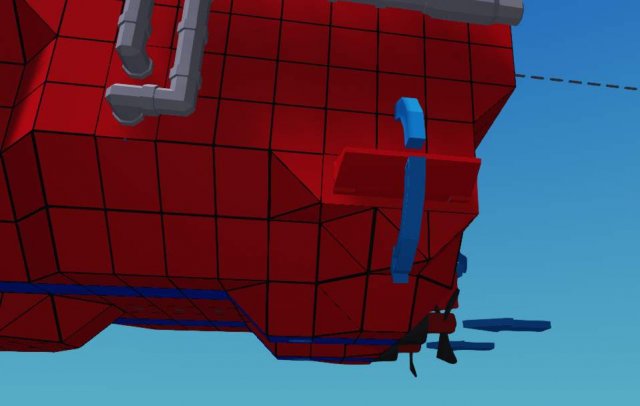
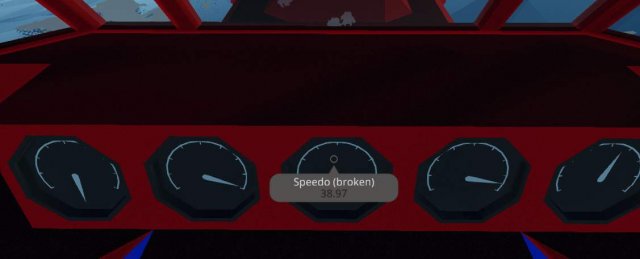
Oh, we just doubled the speed. All right and so.
Cooling improvements
While the engine without any cooling improvements sits at effectually 105 degrees on a steady waveless ocean, the problems begin when nosotros showtime catching air and the engine jumps to a higher place 15RPS. Unfortunately this is also where nosotros become well-nigh of our speed increase, so we have a dilemma:
Solution 1: the piece of cake way out: Limit the engine RPS to 15 on both engines. Bam, you're washed.
Solution 2
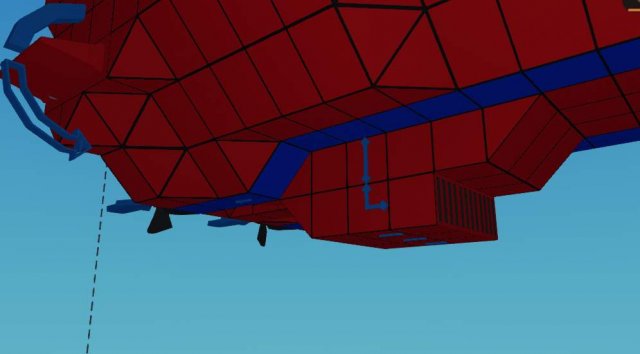
Make a rather large scoop at the bottom of the speedboat. It doesn't need to be 2 deep like mine is, simply this absolutely ensures it keeps sucking up water in a ready manner. This will also increase drag and affect the speed of class, just we do have enough to spare.
So claw it upwardly to the cooling pipe of your engine, place a pump that forces the fluid flow to exist in ane way and forces force per unit area into the cooling organization. I forced this pump to be on with a constant on point for the time being, but information technology's meliorate to hook information technology up to a starter primal subsequently on.
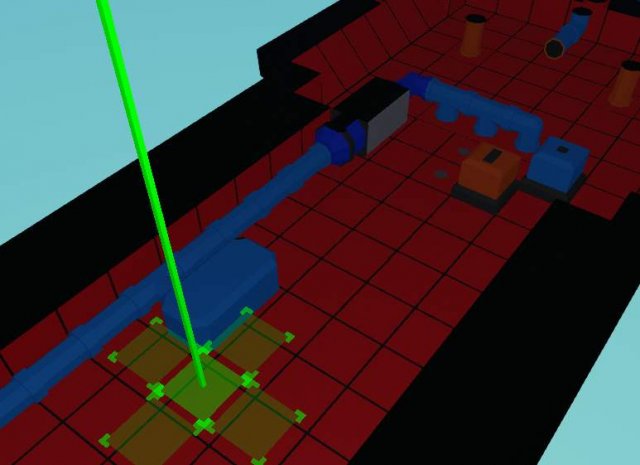
Then make a minor (or 2, or 3) liquid tanks filled with water connected to the cooling pipe with T-pieces, these are reservoirs for the coolant, which is consumed very apace for the 2 engines. They will be useful when nosotros bounciness around with waves, and so the engine will never exist left without cooling.
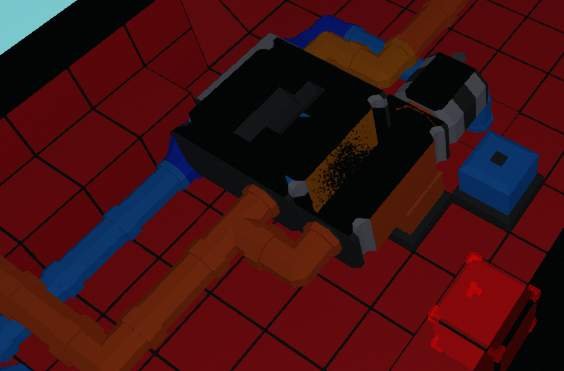
While not really an absolute need, now would exist a good fourth dimension to install an generator. Place it before the gearbox and place it behind a clutch permanently stuck to 0.v or so. This means information technology's taking only a little bit of our engine ability and keeping our batteries charged. Unfortunately the moving picture is somewhat unclear, equally cutting the boat in one-half cuts out the pinnacle of the components.

That should keep it in bank check. The engine heat doesn't really become high in a higher place 30C° now.
Forcing planing
Nosotros use the very aforementioned magical function from the first section, the rudder.
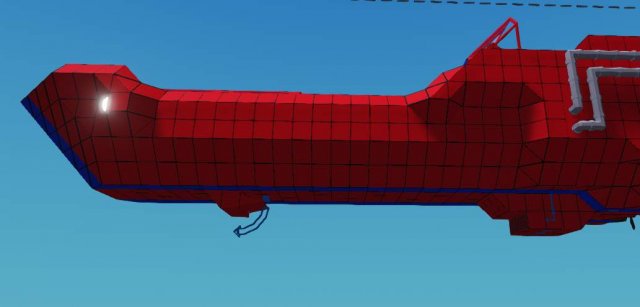
We'll exist placing it somewhere along the lesser, depending how much we desire to plane. I'll put it right around here, though adjusting its position later for farther testing is a adept thought. Then attach a throttle lever to it, and set the throttle'south range betwixt 0.1 and -0.1. Don't forget to give information technology some electrical juice.
Now, what we volition be doing is taking it for a ride, we're looking for a value to permanently bind to it where we aeroplane, but nosotros don't become unstable. Information technology is as well possible to make this reactive, so it only activates at speed with a microcontroller, but given with how many images and deep explanations i demand to give with microcontrollers, i'll pass on that, sorry!
Planing without existence a plane
For me, the value for stable, not-planing is with most 90% throttle and 0.one (annotation that the rudder will be pushing the nose down with this value because of how it'southward aligned in the picture), and 0.05 will allow information technology to plane while keeping it steady.
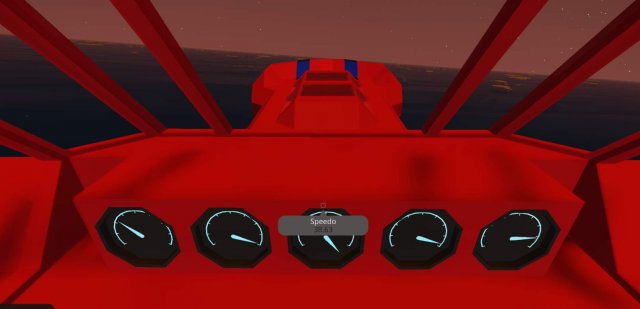
Around 80 knots for a speedboat isn't too bad, is it?
Exploding less dinosaurs
Ah yes, fuel economic system. This ane's easy subsequently all those.
- Render the gearbox to 9:v
- Observe a value for the front fin rudder where it provides lift and so you can aeroplane, for me information technology was -0.i
Exploding more dinosaurs!
That's infeasible, but if you really want information technology to requite all of its performance, move the RPS cap of the engines to 28 or then. It will be very very unstable without any electronic stabilization, and information technology would accept a section of about the size of this whole section to explain. I tin can but wish y'all proficient luck, you absolute madman.
Designing an Accommodating Helicopter for Medical & Rescue
Well, it's finally hither (this statement volition age well later on i've put in all the other sections, won't it?) the helicopter.
- Here's a war criminal offense for you to use.
No, really. I'm non kidding, apparently using the red cross without proper authorization is a violation of the Geneva convention, which makes information technology a war crime! You learn new and interesting things every day.
No, i didn't opt to remove information technology, because i'thou an Egyptian sunday god. (Unless i've changed my Steam name at the point that you read this, and then just imagine whatsoever is appropriate)
Jests aside, this is, without any jokes, the hull of the first helicopter (well, 2d revision of it) that i ever made in the game. I've stripped off pretty much everything out of information technology, then you simply have the hull to work with. I've fifty-fifty removed all the connections, because i'thousand a terrible person! Some just want to watch the world learn…
Just… what's a helicopter?
You know those things called airplanes? They're chosen "Fixed fly aircraft", do you lot know why? It'south considering their wings don't flap, move, plough, or anything like that. They depend on something pushing them so that the air moves over the wings which are designed to generate lift which makes it so that when the airplane moves fast enough, it'south pulled off the ground. Amazing, huh?
Helicopters are rotary fly aircraft. They're called that because some complete genius decided that instead of having wings like planes… what if… yous put those two wings on top of the plane, and instead of something like a prop engine pushing the plane, what if we just spun the wings around? I'one thousand certain that concluded in some sort of a massive explosion and fireball, just somehow we ended upwardly with the helicopter as a result.
"But i didn't inquire that, you're only putting words in my oral fissure!"
Oh past the way at that place's going to be an unusually big amount of theory in this section, considering understanding how helicopters, and their props work is the key to making a good one. Thankfully the previous section takes intendance of a lot, and then permit's actually do something concrete.
Let's build stuff before yous get bored of the wall of text
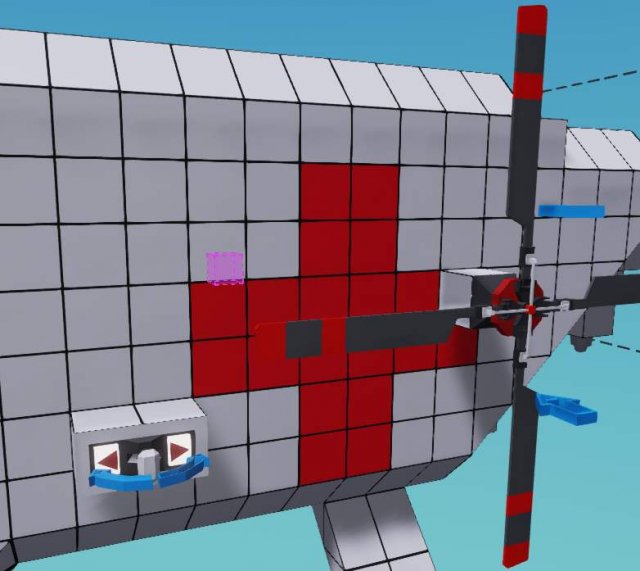
Make this extremely crude addition to the helicopter, the components in question are a throttle lever and a tail rotor
"But that's not a propeller, and that's non where a tail rotor goes!"
Shush, don't brand fun of the tail rotor's size or where it'south situated. It's a perfectly capable helicopter rotor in its own right. Plus information technology's easier to fit on there. Link up the tail rotor's Yaw to the throttle lever, and wire upward some electricity for the throttle lever. Change the throttle lever'southward properties and then the range is -1 to i.
At present just become alee and play with the throttle for a while. You meet what the rotor'southward blades are doing? This is something that's called the collective. Also super secret amazing hidden characteristic: click E or Q on the tail rotor to fold it. Magic.
Nobody expects the Castilian theory section… especially when it'south written in English
"But i thought that was the theory department…"
Yes, sorry, it wasn't, simply i hope this part is really shorter than you think.
Collective is nothing only the set on bending or prop pitch, but for helicopter rotors. It's actually simpler than apparent: The higher the collective, the more lift the prop provides. This also means that information technology has more drag, so the engine has to requite out more torque to rotate it.
The reason i've asked you to also hook in negative, is because negative collective (in example of tail rotor, helpfully labelled yaw) is also a matter. This allows you to turn left and right with the tail rotor, or make an upside down propeller provide upward lift.
If you lot're unfamiliar with the "half dozen degrees of movement" terminology, here's the simple explanation:
- Yaw: Plow Left or correct
- Pitch: Tilt upwards and down
- Gyre: Tilt left or correct
"Tin we finish with the theory now?"
No, because i'm ending this section. Ha-ha, the building function you were looking forward to was in the adjacent department all along! Now y'all know how Mario feels when he finds Toad instead of Princess!
Besides delete that tailrotor and throttle from the side of the helicopter, we won't be needing them.
Designing an All-Around Helicopter for Medical & Rescue pt two…ish, But Non Really
First things first, let's examine the helicopter. The particular importance, like with the speedboat is the center of mass.
"Wait, is this another theory section? I thought you lot said…"
Super quick, super of import, ok? No funny stuff, i'll just get it out of the manner, deal?
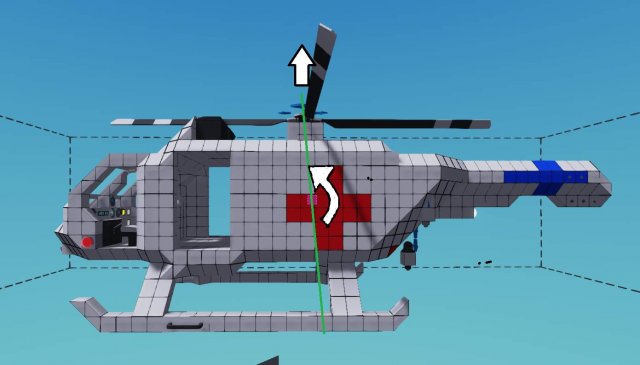
As this highly professional MS paint shows, because this is a pulling, instead of a pushing type of motor (dissimilar the speedboat for example) the force on the imagined "lever" is a more rotational type force that forces the nose to pitch down. Imagine like y'all were dragging information technology around on a cord. This is what the strength is like.
Misaligned center of mass likewise causes a significant amount of instability, so it should be of utmost importance to try and align these equally much as possible for whatsoever helicopter. The batteries are situated where they are to try and adjust this remainder.
It should also exist of notation that when fuel drains, it can easily shift this centre of balance, and then fuel tanks should be situated in line with center of rest.
Now let's actually get to building
Since this is a full general purpose helicopter, and comes with a winch, a unmarried diesel fuel engine lacks power to carry stuff, merely would exist OK for ambulance only. If you only care about range, want to brand it lighter and a medical rescue helo, you can follow this guide by edifice a central single engine instead.
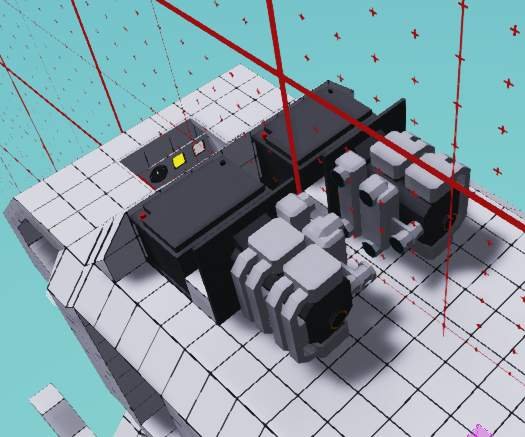
My personal preference is to make the twin engines in designs like this "kiss" eachother. One tile gap between them allows extremely compact engine designs without compromising utility. As before, this isn't actually a pipe beauty guide or anything like that, so i'll walk you through the less obvious ones:
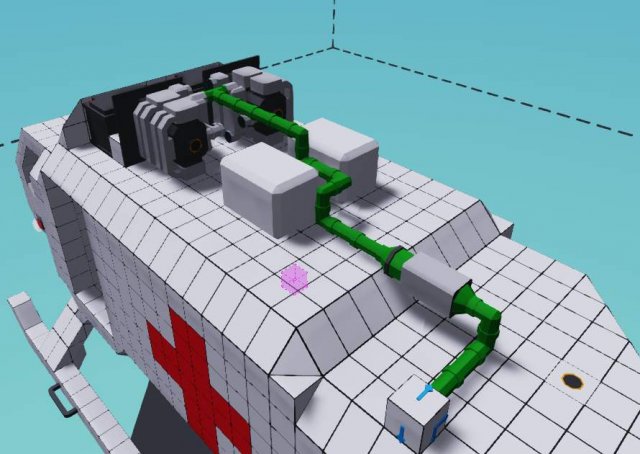
The fuel pipage has a fluid intake situated on the back-end of the craft. A rear-mounted single pump is useful to accept for pushing the fuel all the way to the tanks. Information technology might not be a necessity, just it really isn't a problem on electricity drain either way.
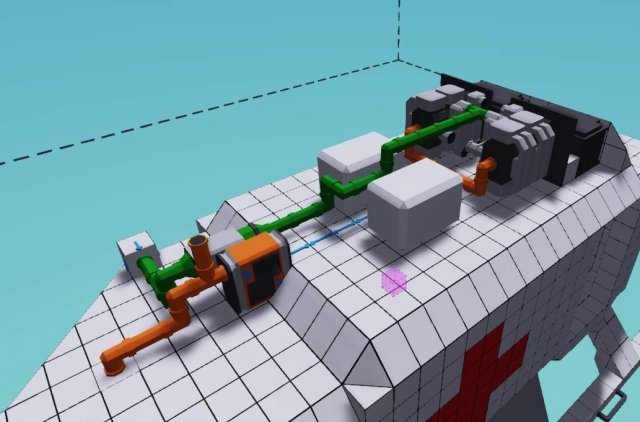
Claw upwardly the drivetrain to the already existing tail and innovate a gearbox along the way, where and how is up to you lot. The tail exists already for your convenience, and has a sneaky footling generator behind a clutch so we can keep electricity topped up.
How y'all pattern the rest of the engine bay, including cooling and air intakes is up to you. This will not use a lot of cooling, the double radiators i used are mostly for aesthetics (and possible time to come tuning). What's of import is that you have all that you demand hooked upwards.

Now would be a good time to hook up that engine by locking its throttle to i with a abiding number and giving it a get. It'due south like shooting fish in a barrel at this point to see the engines all the same so y'all can tell what problems (if whatsoever) they have. Though you could also just remove a part of the interior ceiling to see them, i estimate.
My engines stabilize at effectually 93 and 91 degrees. There'southward ofttimes some weird variance between ii sides, up to fifty-fifty 10 degrees. Don't let it bother you.
The crown on summit of the helicopter
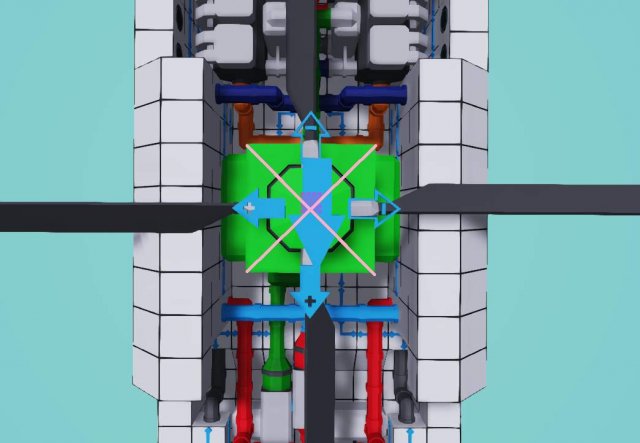
Finally, it's time to put the cream of the ingather on the height. Make very sure the large rotor is as close to in line with with the middle of mass as possible.
In the picture of mine you can see i drew a pink X on top of the rotor housing. You should discover 2 particular things:
- The large arrow is nowhere near centered and is a poor indicator for it being well-nigh the center.
- My arrow is pointing backwards.
The latter just means i will have to inverse my inputs with a multiplication of -1. This is the but time in the guide i will refer to this, as it'due south very possible with your engine design yous can simply place your rotor the right mode round.
Hook up the rotor to the drivetrain backside the gearbox, and then practice the final scrap of covering up of the engine and beauty work, because the engine is going away at present. We won't be seeing it again unless we need to work on it again in the future. Finally, sneak a tail rotor in place, in that location'due south a pipe eagerly waiting there. You can install rudders if yous'd similar to have them.
This is a good time to examination those engines again.
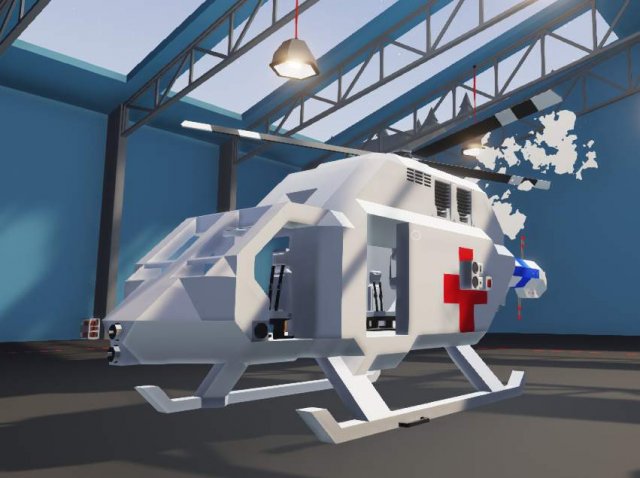
Certain, it looks like a dopey humpback, but it's done from a mechanical standpoint… just why doesn't it fly even with the prop at positive (locks collective to 1)?
A sneaky anecdote
So, there's ii dissimilar types of helicopter:
- Old style: The prop is completely locked on positive, and engine throttle determines how much elevator is gained.
- Modern: The collective is variable and determines the lift, and electronics control the throttle to keep it at a desired RPS.
There's up and downs to both of these systems, the one-time style is more reliable, as there'due south less moving parts, but the modernistic is significantly more flexible and responsive to input every bit it doesn't rely on throttling a combustion engine.
Wiring it upwards
You volition find a lot of the cockpit pre-wired (and mysterious nonfunctional controls for other stuff that aren't there, hmm), the main part we're interested in is the gyro already installed at the back of the seating compartment.
Equally doing an electronically controlled engine requires significant electronics, i will exit that for extra credit, along with a few other things. We will be making an old mode i.
Starting time, install a throttle lever to control the engine throttle, then wire upwardly these inputs on the gyro: Coil, yaw and pitch, leave the up/down alone. Oh, and something to start the engine would be nice. Finally slap the gear ratio of the gearbox to one:2.
After doing all that, wire the stabilized output of the gyro to the relevant outputs. The yaw goes to tailrotor, pitch and curl go to the rotor above. Yous know that part which i said i won't bring up? I lied. This is just a friendly reminder that if your rotor is backwards, your stabilized(!) pitch and coil are reversed. Likely your stabilized yaw is too reversed with how the tail rotor is faced.
You may play with stuff like the ratio later your ain, the reason i'm non going into more detail and explaining the choices amend hither is because i'k running close to the size limit of this section of the guide. I will save more of the detailed explanation for the actress credit part.
Examination run? Test run!
Quick troubleshoot:
- Does it just roll like a washing machine tumbler?
- Invert the stabilized roll going to the rotor
- Does the engine accident up?
- Limit the RPS lower than 20
- Does it stutter weirdly at loftier throttle?
- This is engine tremble, because the engines are peaking out with their RPS and responding to the irresolute load while they're spooling up their own rotations. It's an unavoidable function of using this sometime mode hookup. You lot can get rid of virtually of the engine tremble corrected past the gyro by dividing the stabilized gyre input past a relatively large number, like 5, but this is fixing the trouble and not the cause.
Those are the merely problems that are really possible for this setup…
Finally, exam at what point it lifts off. For me it's 0.55. Information technology might be wise to set the minimum throttle slightly below this for a good landing setting, something like 0.53 worked for me. It is an absolute ability house, but with the rather hard throttle control it'south really not like shooting fish in a barrel to handle, only information technology most definitely flies, and it flies difficult.
In other words, a perfectly functional helicopter, practiced job!
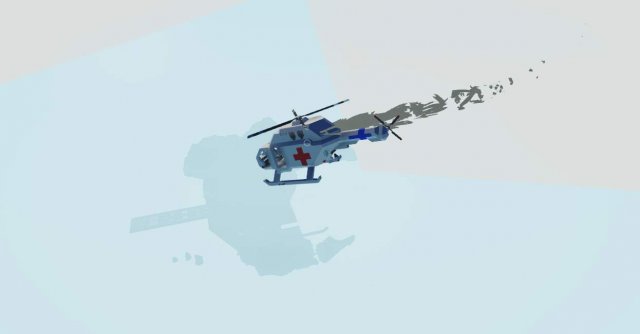
If Internet Historian says "Engoodening" is a word, information technology certain is a discussion!
The entire department is practically defended to making an electronic engine control module, and it'll exist quite low-cal in theory, but if you can't call up with logic gates, it'll be quite complex. Let's go the theory out of the mode:
The theory section
We want the small engines to hover effectually a desired RPS, and we demand the throttle to be automatically controlled to do this. At that place's 2 ways of doing this:
A concrete throttle lever that is controlled by the electronics
- This gives us an like shooting fish in a barrel to see visual representation of what the script is doing.
- In emergency situations nosotros tin can accept an override that disables the script from controlling the throttle.
- Information technology's easy to disable the automated throttle command and turn the throttle to 0 to shut off the engine.
An internal throttle command that'due south handled inside the microcontroller itself
- This is significantly more responsive than the bodily throttle lever fifty-fifty with high throttle sensitivity.
- Requires less size equally a microcontroller every bit it doesn't need the two outputs to the throttle lever.
- Requires less space in the cockpit.
Usually i would favor the bottom 1, but information technology does crave more work to melody the sensitivity of the counter, and is generally a bit more difficult to design. Nosotros'll go with the simpler, if even so more striking option.
First things first
If you've followed the guide so far and are not here to look up upgrades for your helicopter, we only accept a throttle control, without the up/downwards of the gyro beingness engaged. The up/down control from the gyro will control the commonage of the helicopter blades to provide lift. At 0 engagement it will brand the helicopter "neutrally buoyant", or close enough. In reality this won't be quite exact, equally every helicopter and state of affairs is a niggling scrap different.
Here's what we'll do:
You can either hook up another throttle lever for the up/downwards adjustment in the cockpit, or but wire it to upward/down on the seat. For the throttle lever you'll need -0.4 as the minimum for a good landing setting.
After hooking upward the lever to the gyro, hook upward the stabilized upward/downwards to the collective of the helicopter blades, then brand very sure to set the prop of the heli to neutral. This will allow adjusting the collective of the prop itself.
Return your throttle'south minimum setting to 0, then connect its electrics to an electrical relay so that it tin can merely go juice when the relay is on. If yous haven't used 1 before, it's an electric switchbox that's controlled by an on/off bespeak. We will apply this to disable the manual utilise of the throttle lever when the override is on.
The relay isn't absolutely necessary, and you can have a 2×2 microcontroller instead without it, simply adding information technology won't be much trouble.
Let'due south get to the electronics, with some pictures!
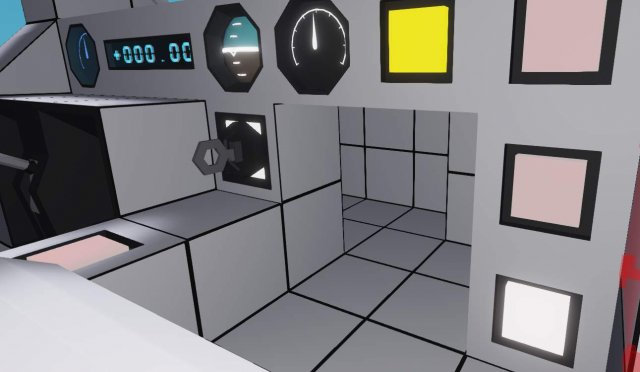
Let'south dig a prissy pigsty for that microcontroller, the two×3 space hidden backside the panel should be plenty. You need to dig in at that place a little bit, only it's fine.
Let's design the microcontroller now, we'll need the following:
- Override input (on/off).
- RPS Input (number) > one is enough, the engines are stuck on the same drivetrain.
- Throttle up output (on/off).
- Throttle down output (on/off).
- Relay output (on/off).
We're going to apply a similar layout to this. Let'due south lay out our already existing pieces in a sensible mode.

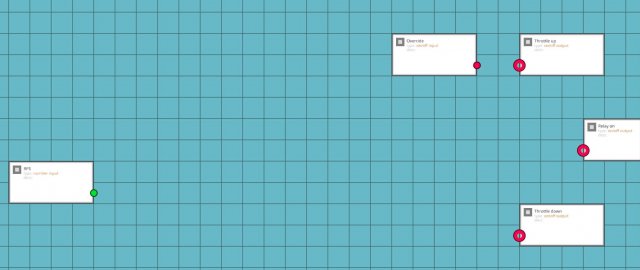
Prissy. The far left will feature RPS but, because nosotros'll need some logic to handle information technology, the correct manus side will feature our assortments of other stuff. We will be using the override afterward, so it's off to the side.
Chips we need:
- Less than > Hopefully obvious.
- Greater than > As in a higher place.
- Property number > Easily modifiable number that you lot can suit in properties.
- Add >
- Substract > These two modify the property number.
- 2x Constant number > Fix at 0.5 so we have a desired range.
Lay them out equally such
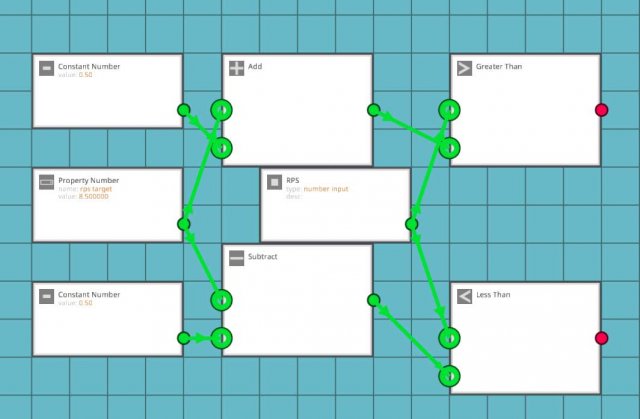
I will endeavor to explain the logic behind these in the first paragraph later every picture, if yous're already decent with logic, you can skip this role. Firstly, we're using 2 constant numbers only so it'south easier to read. The incoming number sets the desired target, the addition and substraction creates a range of +0.five and -0.5 from that value, this compares the RPS coming from the engine to see whether or not information technology is larger or smaller than the desired value.
Nosotros tin also make information technology so that the desired value tin can be determined by things like keypad input, but that'southward for you to do if you wish to practise that. At present that we take the comparative logic in place, let'southward handle the outputs logically
Chips nosotros need:
- Or > And then that either greater or bottom than input enables the relay so that the script can alter the throttle.
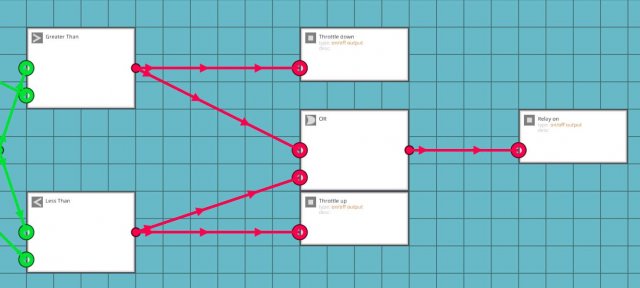
Well, that was simpler than expected, wasn't information technology? This setup enables the relay whenever either greater than or lesser than condition is met, and allows the adjustment of the throttle. However, it disables the relay when either condition isn't met (the throttle is in desired range), and thus disables you handling the throttle lever.
Ok, information technology'll take a little chip of thinking to exercise the override properly. Our easiest style is probably to assault the numerical section of the electronics, as explaining how to override the binary logic itself would be a little fleck more complicated.
Chips nosotros need:
- 2x Numerical switchbox > We switch out the RPS input for a desired value.
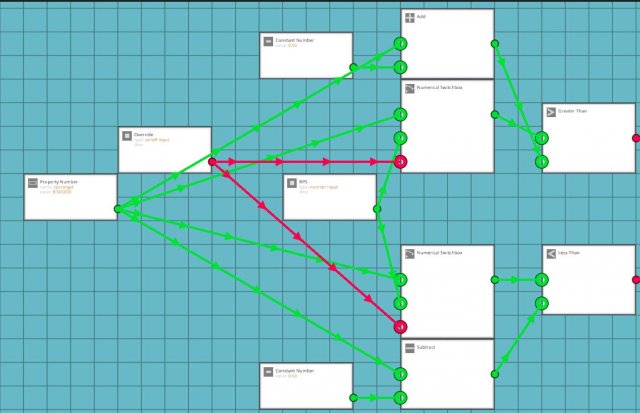
It might be a little hard to read, but the RPS values are on the "off" state inputs of the switchbox (when override is not on), and the desired number is on the "on" country of the switchbox inputs, which are linked to the bottom and greater than A ports. This means that when override is on, the electronics think that the engine RPS value is always at a desired state.
We're however missing one little matter, forcing the override to enable the relay
Fries nosotros demand:
- 2x Non gates > Optional, i use these in pairs (they abolish eachother out) to route the bespeak. Makes it easier to read.
- Or > For notwithstanding another fork to the relay input.
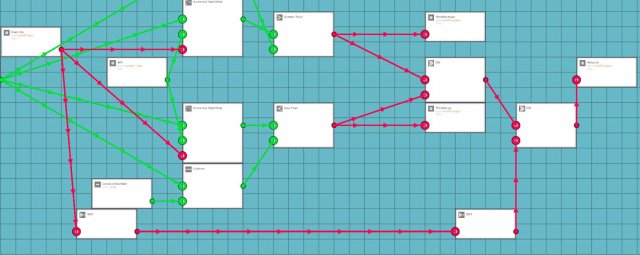
This makes another OR-fork for enabling the relay. Equally you can see, the paired Non gates makes a nice routing for the signal, instead of it just crossing over everything.
I'm sure you tin figure out where and how to wire these, just just in case there's someone who's still very much learning english, or but having a dislocated mean solar day (and doesn't want to ask the lightheaded question) here'south the breakdown:
- RPS takes in the RPS value of whatsoever engine.
- Override takes in a toggle button.
- Throttle up goes in to the up input of the throttle lever.
- Throttle down goes into the downwards input of the throttle lever.
- Relay connects to the electrical relay that is connected to the throttle lever.
If you lot're flying the helo made with the department above, set the desired value to xi, then set the gearbox to 1:3.
Testing time
So… information technology kinda works. If y'all gun the collective, but you lot before long accept to striking the override and handle it yourself. What's wrong?
What'south happening is that the script is failing to have into account that the engine is taking time to respond to the throttle input. It'southward trying to adjust the throttle wanting an immediate reaction from the engine. This would work with an electric motor, merely we demand to look at something else.
Let's get back to the script for ane more terminal swing at it.
Note: This section ran out of text space, how awkward.
I more than tweak, that'll surely exercise it!
Fries nosotros need:
- Delta > High schoolhouse maths. The difference of a value given a unit of measurement of time (in this case, 1/60 of a second).
- Greater than >
- Less than > These 2 for comparisons.
- 2x Abiding value > To be compared against.
- 2X and > The RPS value is beneath and not rising or The RPS value is above and not dropping.
- 2X not > Read above.
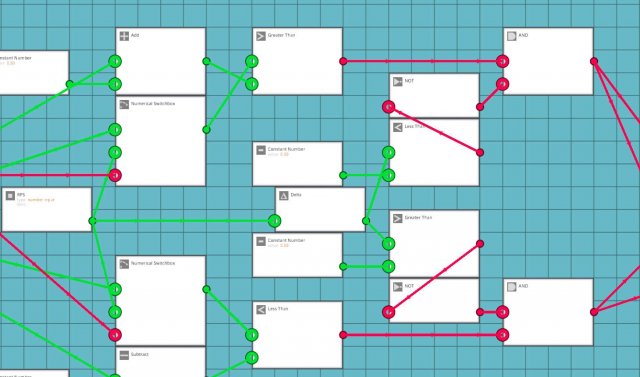
It'due south easier to describe the logic here equally the computer reads it. Call back, delta looks at the deviation of the RPS value, so nosotros volition know if the engine is spooling down or up.
Here's essentially what the entire chip does:
- If RPS is less than desired value and not already rising: Enable relay, increment throttle.
- If RPS is more than desired value and not already dropping: Enable relay, reduce throttle.
- If override is on, RPS = Desired value: Enable relay.
The 0 setting for the constant numbers is not error-free. Something similar 0.01 or 0.005 would likely work improve. You'd have to detect the delta number to figure out what'south a good value for it. Calibrating this value is pretty engine setup specific, but it won't take too much trial and fault to figure out. All it takes is making a temporary number output and getting the readout on the delta value on something and so you can watch the decimals piece of work.
Let'southward test again, like nosotros did last summertime
Hey! If you lot wired up everything correctly, it'southward perfectly functional now. It responds relatively fast, and stabilizes the engine by throwing the throttle effectually.
The only problem with this is that it does so little chip also eagerly, this is more often than not a very mild annoyance type of problem, as it revs the engine up and downwards to keep within the target. The only way to deal with this particular problem is to make another logic department that handles the fine adjustments of the throttle lever itself. Basically this is what you need to accept:
- If RPS is within +/0.3 of desired value: Do very curt touches on throttle to find the sweetspot.
- Something more than reactive likely works best, like:
- If RPS is less than 0.three more than desired value and delta is in a higher place 0, reduce throttle for 10 corporeality of ticks
- If RPS is more -0.3 less than desired value and delta is below 0, increase throttle for X corporeality of ticks.
This i will leave for you to figure out how to practice, but i'll say it isn't very hard to do. I'll give you lot a hint: The timer logic blocks allow you to configure them to output things for 10 amount of ticks, you can multiply the accented (removes negative) delta value to get an verbal adjustment for desired throttle, but it'll demand some trial and error. You probably want the timer that outputs when it is less than its set duration. If you want one-tick adjustments and can't figure out how to bargain with the clocks, a combination of toggle to push and blinker permit you to put out 5 or 10 signals per second equally opposed to 60. Or, you know, y'all could merely employ a PID, merely where's the fun in that?
Success!
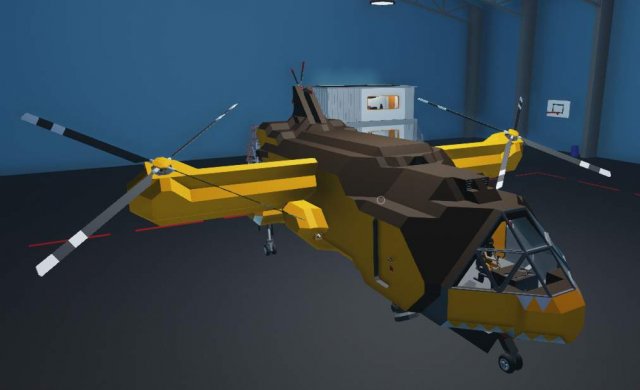
This department is mostly meant for what it looks when you design a department of a guide without testing the concept firsthand. I left information technology in as a curiousity more than anything else, delight do not follow this for your sanity'due south sake.
Let'southward outset building. My outboard will be slightly flossy with red racing stripes.
The engine should be seated so that the coolant in/out piping is either in line, or i behind the concluding block on the Dinghy. Yes, information technology will exist comically huge considering nosotros're using the "small" diesel fuel engine, but this is fine.

This is an easy mode of dealing with cooling. If you desire a rotary version of the outboard, y'all'd have to integrate the cooling into the downward reaching part of the outboard with the prop, only information technology'southward relatively like shooting fish in a barrel to piping.

When dealing with exhaust and fuel, we should bulge out the outboard's cowling (the trounce of it) and so we can hide encased piping where we want it. This was my design of choice, simply you tin can just pipe it out the side also.
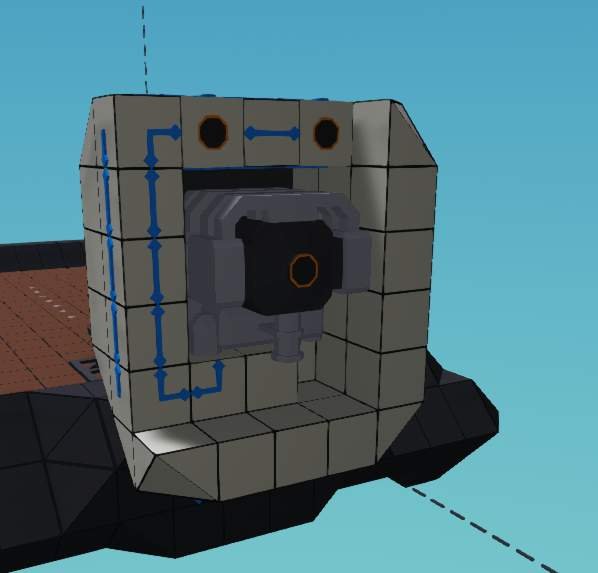
This is my solution for the air intake. Unsurprisingly, the most important feature of the air intake is to take in air, just at the time of writing the engines don't care if h2o gets in it fifty-fifty for a good while, y'all don't need to brand a filtration system.
For the tank i would use a custom enclosed tank, simply since this is attached to a dinghy and the weight would exist absurd, i'm in fact going dorsum on that design and merely tucking on a small-scale tank, as it'southward enough for testing, and for later use the outboard can be taken off and used as a subassembly!
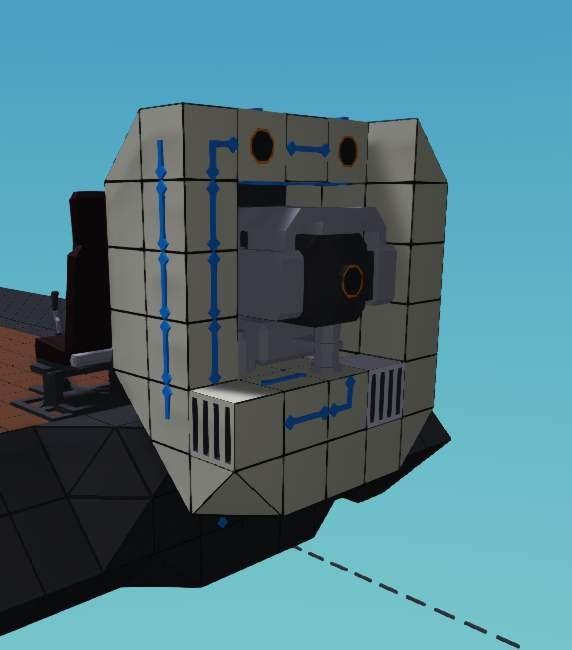
Finally, we should hide a gearbox in the bulky form of the comically huge outboard engine.
Brand sure that the gearbox's arrows are pointing toward the engine, since nosotros want to increment the RPM.
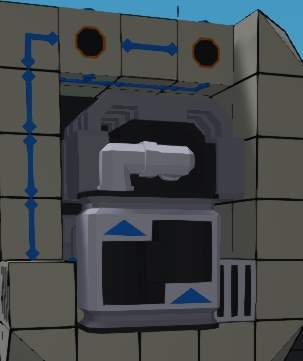

So finish the rest of the cowling and brand sure the damn affair floats.
Testing fourth dimension!
Now as said before, nosotros're working technically confronting a constant load. So wire that sucker upwardly in any way you similar, attempt for 2 gear ratios that audio feasible to you (like 2:3 and 1:2) and fix to examination it out.
Here's the dials (or other readouts) that we want:
- Engine heat (optional, but good to run into).
- Engine RPS (accented must for fuel economy tuning).
- A visible style to run into whether or non the gearbox is toggled on.
- Fuel tank'southward contents.
- Speed.
What we're looking for
Signs of the gearing existence too low:
- RPS increasing to a higher place 8 on a pocket-sized engine (unless y'all don't care almost fuel efficiency, then 10-12 RPS is a good target).
- The boat becoming unstable (this tin can be addressed with hull design).
- Excessive fuel consumption.
Signs of the gearing being besides loftier:
- Excessively tedious offset (slow start is ok, since we have 2 gears to play with we can apply the other i as well).
- RPS stays constantly below 6 even subsequently reaching full speed.
- It doesn't start at all (very hard to do in a gunkhole).
After flipping my boat a few times with the excessively heavy outboard, i've come to a value of v:nine for the gearbox being perfect. RPS sits around seven.ii and rises up to nine if i catch some air, only never enough to flip the boat if i feather the throttle a little flake. It can reach near 10m/s before becoming unstable.
So what have we learned (possibly):
- Heavy outboards on small rubber dinghies are dumb and crusade information technology to flip.
- If there was more weight toward the front of the craft, we could go faster without flipping.
- Getting that right gear ratio for a boat requires a few exam runs, so it probably should exist washed last.
Recommended for You
Source: https://gameplay.tips/guides/6531-stormworks-build-and-rescue.html
Posted by: bradleytheavizar1974.blogspot.com


0 Response to "How To Get More Speed Out Of My Boat"
Post a Comment